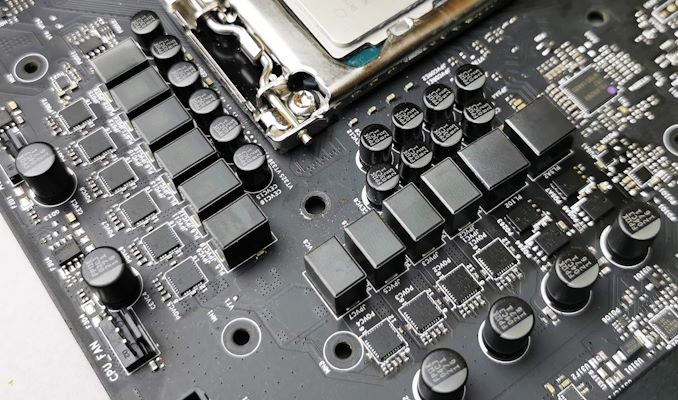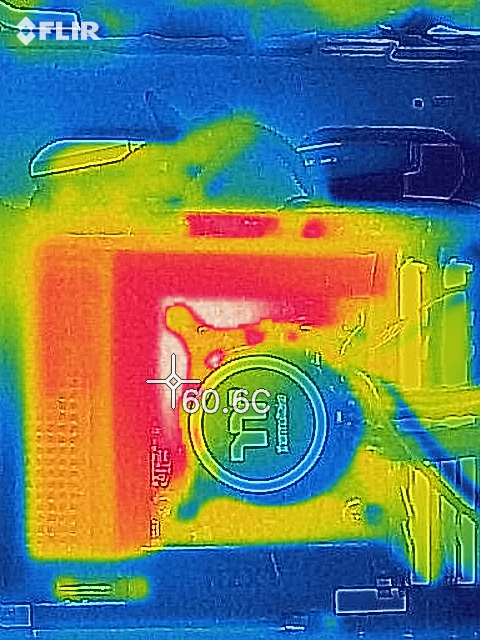The NZXT N7 Z490 Motherboard Review: From A Different Direction
by Gavin Bonshor on October 7, 2020 10:30 AM EST- Posted in
- Motherboards
- Intel
- ASRock
- NZXT
- Z490
- Comet Lake
- Intel 10th Gen
- i7-10700K
- N7 Z490
Power Delivery Thermal Analysis
A lot more focus has been put onto power delivery specifications and capabilities, not just by manufacturers, but as a result of users demands. In addition to the extra power benefits from things like overclocking, more efficient designs in power deliveries and cooling solutions aim to bring temperatures down. Although this isn't something most users ever need to worry about, certain enthusiasts are bringing more focus onto each board's power delivery. The more premium models tend to include bigger and higher-grade power deliveries, with bigger and more intricate heatsink designs, with some even providing water blocks.

The 8+2+1 power delivery on the NZXT N7 Z490
Testing Methodology
Our method of testing out if the power delivery and its heatsink are effective at dissipating heat, is by running an intensely heavy CPU workload for a prolonged method of time. We apply an overclock which is deemed safe and at the maximum that the silicon on our testbed processor allows. We then run the Prime95 with AVX2 enabled under a torture test for an hour at the maximum stable overclock we can which puts insane pressure on the processor. We collect our data via three different methods which include the following:
- Taking a thermal image from a birds-eye view after an hour with a Flir Pro thermal imaging camera
- Securing two probes on to the rear of the PCB, right underneath CPU VCore section of the power delivery for better parity in case a probe reports a faulty reading
- Taking a reading of the VRM temperature from the sensor reading within the HWInfo monitoring application
The reason for using three different methods is that some sensors can read inaccurate temperatures, which can give very erratic results for users looking to gauge whether an overclock is too much pressure for the power delivery handle. With using a probe on the rear, it can also show the efficiency of the power stages and heatsinks as a wide margin between the probe and sensor temperature can show that the heatsink is dissipating heat and that the design is working, or that the internal sensor is massively wrong. To ensure our probe was accurate before testing, I binned 10 and selected the most accurate (within 1c of the actual temperature) for better parity in our testing.
To recreate a real-world testing scenario, the system is built into a conventional desktop chassis which is widely available. This is to show and alleviate issues when testing on open testbeds which we have done previously, which allows natural airflow to flow over the power delivery heatsinks. It provides a better comparison for the end-user and allows us to mitigate issues where heatsinks have been designed with airflow in mind, and those that have not. The idea of a heatsink is to allow effective dissipation of heat and not act as an insulator, with much more focus from consumers over the last couple of years on power delivery componentry and performance than in previous years.

NZXT N7 Z490 undergoing our VRM thermal testing (we close the side panel when testing)
For thermal image, we use a Flir One camera as it gives a good indication of where the heat is generated around the socket area, as some designs use different configurations and an evenly spread power delivery with good components will usually generate less heat. Manufacturers who use inefficient heatsinks and cheap out on power delivery components should run hotter than those who have invested. Of course, a $700 flagship motherboard is likely to outperform a cheaper $100 model under the same testing conditions, but it is still worth testing to see which vendors are doing things correctly.
Thermal Analysis Results

We measured 60.6°C on the hottest part of the PCB which was around the CPU socket
The NZXT N7 Z490 is using a 10-phase design for the power delivery, which is being controlled by an Intersil ISL69269 PWM controller. It is operating in an 8+2 configuration, with eight Vishay SiC632A 50 A power stages for the CPU VCore, and two Vishay SiC632A 50 A power stages for the SoC.
It is cooled by a decent-sized L-shaped heatsink, and although it doesn't use a fin array, it has a hollowed-out channel to help direct airflow through this to keep it cool.
Focusing on the power delivery thermals, the NZXT N7 Z490 doesn't do a bad job, with the board's integrated sensor reporting a maximum temperature of 61°C. This was similar to the readings we got from our pair of K-type thermal probes with temperature readouts of 62 and 61°C respectively.
Compared to other boards we have tested so far, it runs quite warm for an ATX sized model, but it is still well within the rated specifications, which is clearly a plus. The design of the heatsink could be better, but NZXT appears to have focused solely on aesthetics as opposed to raw performance.












45 Comments
View All Comments
Slash3 - Wednesday, October 7, 2020 - link
...The Aristocrats!SaolDan - Wednesday, October 7, 2020 - link
Love it!EWP - Wednesday, October 7, 2020 - link
I love it! Perfect response to the "must-have feature" whiners that long for the days when all "real" computers needed to be build is "super tower" cases to make room for their one HDD, one CD-ROM, and maybe three expansion cards (video, sound, and modem) along with 4+ more empty slots that they never filled.I do have one complaint though. I was expecting an integrated micro nuclear reactor instead of a PSU...they are so last millennia. As if. Primitives.
jabber - Thursday, October 8, 2020 - link
Yeah I don't know why those folks just don't buy a big server/workstation and leave the rest of us to get on with stuff.Cooe - Wednesday, October 7, 2020 - link
Stay off amphetamines kids.m00bee - Wednesday, October 7, 2020 - link
lol, where is like buttonprophet001 - Wednesday, October 7, 2020 - link
Eh... this thing is a hotbox.Makes sense though seeing as how their cases are hotboxes too.
Flunk - Wednesday, October 7, 2020 - link
Looks good, ASRock is a decent OEM... shame about the Intel. I'm buying a new high-end board soon but it's going to be AM4.Arbie - Wednesday, October 7, 2020 - link
So they aim at a niche market (Intel CPUs) and fail at the one remaining (alleged) attraction of those chips: manual overclocking.Gigaplex - Wednesday, October 7, 2020 - link
Intel CPUs still tend to get the highest performance in games. That may change soon with Zen 3.I do like how we're even considering calling Intel "niche" these days though.